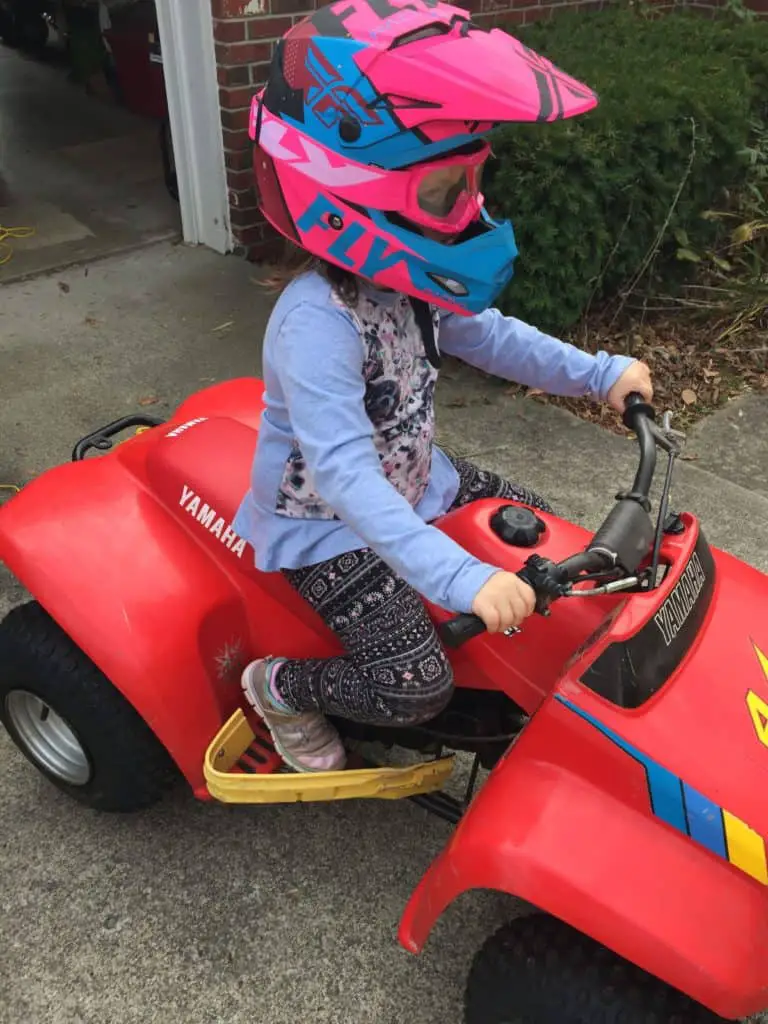
I received a call from my dad three weeks before the holidays asking about getting my youngest daughter an ATV. I knew a safety conscious approach to learn how to ride is mandatory for my wife. Here are a few things I considered that will help you.
How do I teach my child to ride safely and have fun? There are 4 steps for teaching kids how to ride.
- Approach riding with a safety first mindset.
- Outfit your child with properly gear. At a minimum, with a helmet, boots, and always wear pants.
- Get the child familiar with the ATV or dirt bike.
- Practice basic skills at slow speeds and gradually add new items and speed. Make sure you always supervise the child riding.
Many parents new to motorcycles (frankly many who have been riding for years) show kids bad habits along the way. Let’s talk about these steps and answer a few questions regarding safety.
How Big Do My Kids Need To Be To Ride An ATV Safely?
If you go by most recommendations, you find that 6 is the minimum age for kids to ride an ATV. There is a big problem with this in that age does not account for size and nor capacity to ride.
Let’s face it, kids come in all shapes and sizes. There are tiny 6-year-olds and large 5-year-olds. The point being, going off an age limits misdirects parents on when their kids should learn to ride.
As we discuss a little later, the two most important guides to when kids should ride are physical ability and showing good judgement.
Back to the size of your child. I would suggest using 45 to 50 pounds as a starting point for when your child might start learning to ride. Anything less than 45 pounds and the risk to the child becomes too large. The weight of even the smallest ATV is too high for the kids.
You will know when your child exercises good judgement with a few of the items we talk about later. You can also tell by listening to what the child says about traffic while riding in the car or watch how they play with cars. Does it follow a pattern which can safely transfer to an ATV?
What Safety Gear Should My Kids Wear While Riding An ATV?
Remember what I stated as the first step? Approach riding with a safety mindset. Well, it starts here with the gear the kids wear.
At a minimum, kids should wear a helmet to help protect their little noggins. Here is the approach I use to make sure my kids wear a helmet and feel good about it.
The kids should help you pick out the helmets to reflect their taste. This increases the likelihood she will wear the helmet at all times.
Boots and Shoes
Wearing boots or closed toed shoes is another requirement at our house. When I was a kid, I remember breaking this rule once, and it was the one time that things went badly. I wore flip-flops and ended up having a peg dig into my ankle. I was hobbling for weeks.
Without getting into a lot of detail about motorcycle boots, they are nice to have if your child rides a lot or you plan on getting them into racing. They provide better protection for your ankles and lower legs.
Riding boots are not essential though. They can be expensive. If you do not buy riding boots, use these tips to make sure your child operates the ATV safely.
- Put your child on the ATV in properly size closed toed shoes (some for of boots.) This affects his or her ability the pegs and foot controls. Their feet will slide around inside the boot increasing the likelihood a foot may slide off.
- Make sure your child can move their feet around on the pegs. ATVs require a lot of body movement and feet end up in multiple positions on the pegs.
While the ATV is not running have the child stand on the pegs and move around as if they were practicing different maneuvers. While she is moving around pay attention to potential threats for the boot to get stuck or catch a toe if it hangs to low below the peg.
Try a different pair of boots if you cannot correct the problem areas.
Why Kids Should Wear Pants While Riding An ATV
Riders must wear pants too. Pants prevent the exhaust from burning your legs. The same incident where I wore the flip-flops also involved shorts. My leg was burnt badly because I did not wear pants.
There are special pants made for riding that go with riding boots. If you buy one, you will most likely end up buying boots and pants.
Again, these are more expensive than buying pants that a child wears every day. A good pair of pants will cost $40 to $75.
If you do not plan on buying riding pants, make sure you have the child wear material that does not melt easily. I can tell you from personal experience that wearing anything polyester makes for instant trouble. Recently while riding my Harley to work, I quickly found out how easily polyester melts. Boy, does it hurt.
When I was a kid and to this day, I mainly wear jeans while riding. It does not provide the level of protection as riding pants, but it’s better than most other kinds of material.
You should look for the following if your child will not wear riding pants.
- You do not want the pants to be loose. Loose pants get caught in different parts of the ATV.
- If the pants get wet (riding in the mud is the best part of riding an ATV), will the heat from the exhaust easily transfer through the material? Think about the last time you took something warm from the oven using a wet pot holder. OUCH!
- Will the pant material rip easily? Accidents will happen and the child will end up sliding across the ground at some point. Avoid material that rips easily. I have had good luck with jeans.
Chest Pads
Chest pads are another common piece of gear that kids wear. This piece protects the child’s vital organs and ribs. They also help reduce the impact of getting the wind knocked out of you. If you ever experienced this, you know how scary it is when you cannot breathe.
Chest protectors run $40 to $60. Know you will replace these as he grows. Not all protectors are the same. Make sure you research the material they make the protector from. This works by transferring energy around or away from the body in case of an accident.
Gloves
Gloves commonly make the list of essential gear. I put this item last on the list because it is the least important (unless it is winter.)
The gloves should fit well and not impede the rider form operating the ATV.
The first time my daughter got on her ATV it was cold out. I worked with her showing her the different controls and how they worked. While trying the throttle, we quickly found out the gloves she was wearing would not work. She could not keep a grip on the handlebars. We switched gloves. The new pair took a lot of hand strength she tired quickly.
Know that finding the right pair of gloves may take a while if riding it the winter.
I think they should leave wearing gloves during the warm months to the preference of the rider.
Gear Wrap Up
As you can see, after reviewing all the items above, it is not cheap.
| Helmet | $100 |
| Boots | $100 |
| Pants | $50 |
| Chest Pad | $75 |
| Gloves | $15 |
| Total | $340 |
If you skip some items, use the tips for replacement items so your child does not get hurt.
Skills Your Kid Should Master Before Riding An ATV
Before your kid gets riding gear, there are a few things you should look for to tell you they are ready for the responsibility of an ATV.
Specifically, being able to make good decisions on the fly.
As I mentioned before, watching how your child plays with cars and listening to their conversation of other vehicles while riding in a car provide a few good insights on their ability.
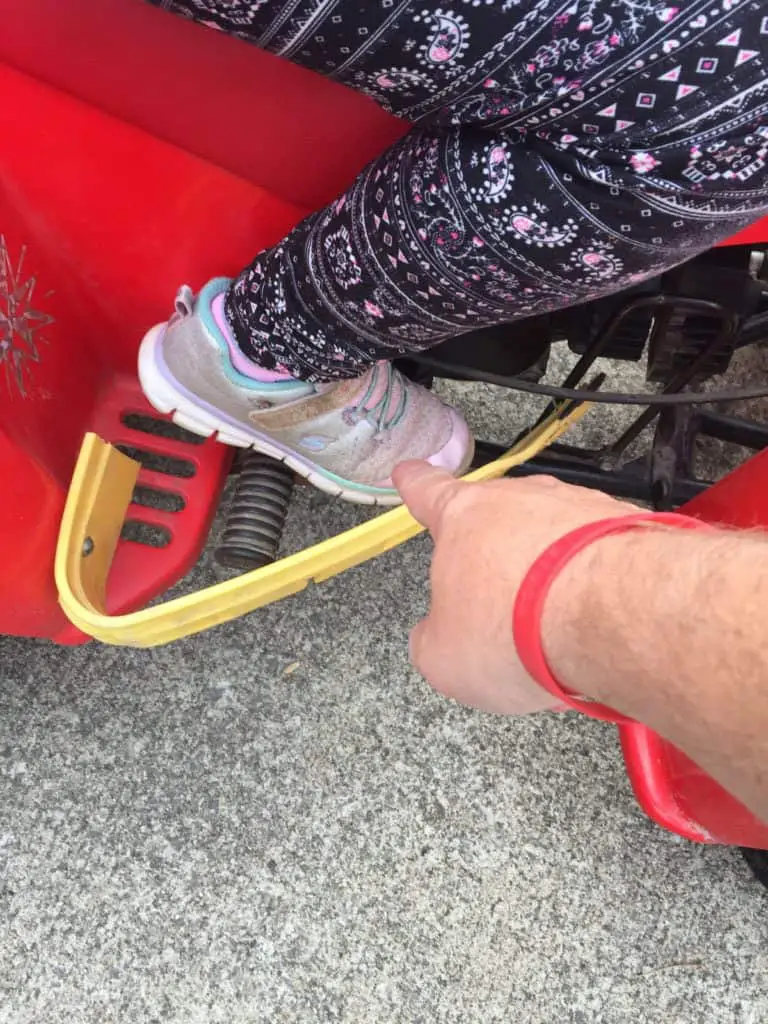
Run the child through the bicycle test several times and you will know if they are ready to ride an ATV.
What is the bicycle test?
The best way to illustrate the test is by a story.
I can remember wanting to ride more than anything in the world when I was 5. My older sister, dad, and uncle all rode dirt bikes. It looked fun, and I was missing out.
My poor dad was bugged endlessly to teach me to ride (they did not invent ATV’s at this point in time.) He told me, “Learn to ride a bike and I’ll teach you to ride a motorcycle.” This was late spring.
During the next 6 weeks, I devoted all of my energy to learning to ride a bike. Barely knowing how to ride a bicycle, my dad taught me how to ride a dirt bike.
The problem was I could only stop by running into something. My mom talks about the big thuds she would hear to this day. Running into something was the only way I could stop. Here, I frequently ran into the house.
The point, your child needs to learn how to ride a bike before you even entertain teaching them how to ride an ATV. Here is why:
By learning to ride a bicycle, the child will learn how to control things like speed and stopping. They will also learn how to exercise good judgement around riding the bicycle. Examples include riding around cars, friends, and other traffic while on walks with mom and dad.
We control all of this and at low speeds. Unlike my situation, make sure they know how to stop.
When you child can do this successfully, then and only then will it be time to introduce them to the world of motorcycling and ATVs.
How big should the ATV be?
Here is a chart to act as a starting point.
| 70cc and under | Kids 10 and under |
| 70cc to 125cc | Kids 11 to 15 |
| 125cc to 250cc | 16 to beginner adult |
| 250cc to 400cc | Intermediate adult |
| 450cc and over | Advanced |
The older the rider the less stringent you need to be with the chart. One downfall to a chart like this is when a child falls on the borderline. Let me explain why.
Obviously smaller ATVs have low amounts of power and as a child gets older, their weight increases. A 12 year old riding a 70cc ATV is not very exciting especially if he has been riding for a while.
Once you have been watching the young rider for a while, you will know when they are ready for a bigger ATV.
The chart also assumes your ATV is a 4 stroke machine. 2-cycle ATVs have more power per cc than a 4 stroke. We can get into the technical differences another day.
If you don’t know how to tell the difference, here are three quick ways so you do not put your child on a large ATV.
- There is a distinct sound difference between 2-cycle and 4-cycling engines. The 2-cycle will have a higher pitch with a pinging sound. The 4-cycle sounds more throaty and deeper.
- A 2-cycle engine will produce smoke all of the time. A 4-cycle will not (provided they tune it right.)
- 2-cycle engines need a special oil put into the gas to run. This happens by either mixing the oil directly into the gas or you put the oil into a separate tank that injects the it into the gas before combustion.
Getting The Child Familiar With The ATV
Your little one has the right gear, passed the bike test, and has the correct size ATV. Now the super fun part starts for the child.
While not running, get the child on the seat and have them climb all over the ATV. Let them explore and ask questions. Let them pull levers and turn the bars.
If you don’t have the ATV available for the child to climb on, I would suggest taking them to the local ATV dealer. I did this with my child while on our trip to buy her helmet.
Before we looked at helmets, we walked around the showroom floor. I was looking to see what her reaction would be. Was she excited and ready to ride? Was she pretending to ride? These are indicators they want to ride.
After we bought the helmet, my daughter wanted to sit on the 4 wheelers again to pose for pictures.
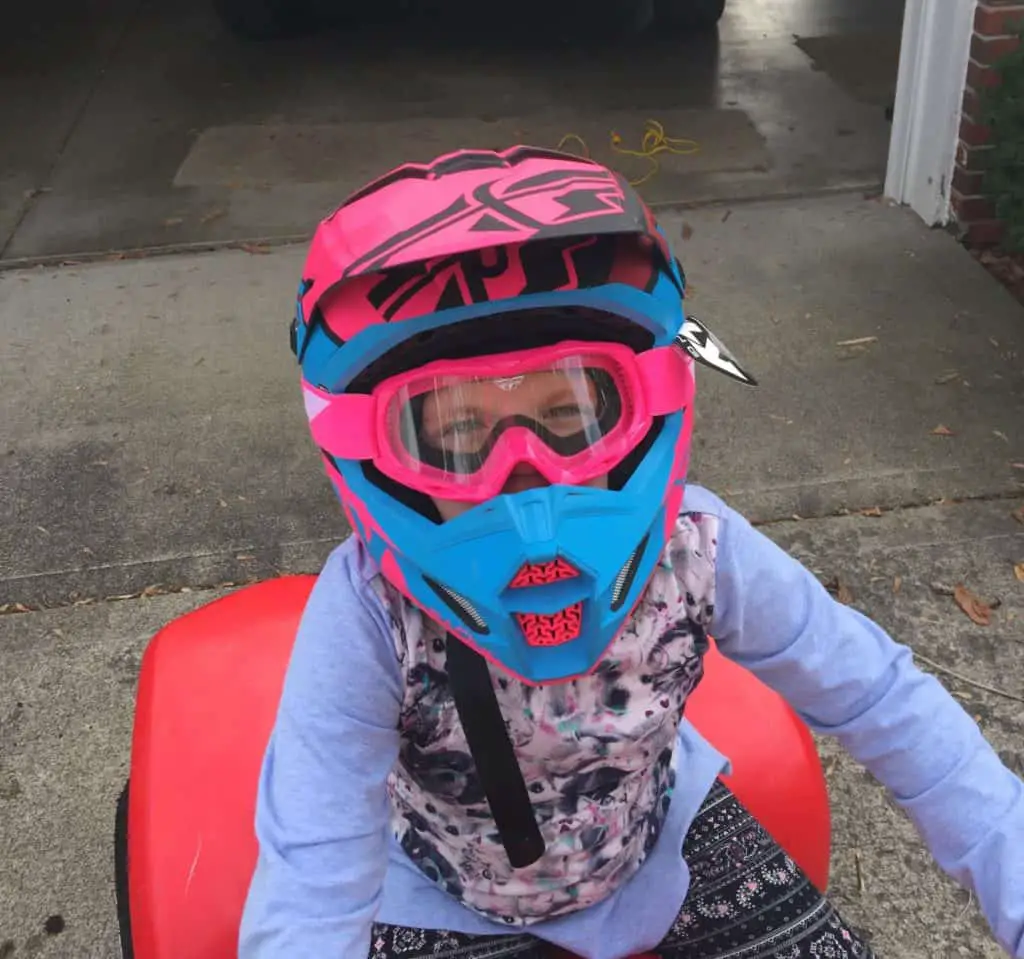
After they climb over the ATV, interact with them. Ask them questions.
- What do you think happens when you pull this lever?
- How do you think your feet should sit on the pegs?
- How do you think it starts?
- What do you know about turning off the ATV?
- How do you speed up?
- How do you slow down?
Help them answer the questions. Your little one will be excited to ride and learning how to use the different elements on the ATV.
Practice Drills For Kids On The ATV
Before sending them off and hoping they get it right, use the following drills to help the kid start applying what they learned from crawling around on the ATV and answering your questions.
- Place the ATV in an open setting and put the rear wheels up on a block or jack stands. Make sure it will not come off whatever stand which you place it.
- Put a throttle stop in to prevent the ATV from running wide open. This will also reduce risk in the even the ATV comes off the stand.
- Have the child get on the ATV again and crawl around.
- Have the child put on their helmet. Start the ATV and let it warm up. Before you do, I would suggest you let them know what you’re doing. Once started watch their reaction. If they panic, crying, or look worried shut the ATV off immediately and come back another day. You want riding to be fun and you should not force them.
- After the ATV has warmed up, have the child practice. Have the apply the throttle giving it gas and letting off.
- Incorporate the brake. It will take time before they become coordinated enough to instinctually apply it. Do not be surprised because they may confuse their bicycle brake lever and the ATV brake lever.
- After mastering the throttle and brake, take the 4-wheeler off the stand. Tie a rope to the kill switch. The throttle stop should prevent the ATV from moving any faster than a light jog. You may have to adjust it a few times.
- Have your child do big circles practicing the brake and throttle. Make you change directions every so often. Otherwise it gets boring and their little muscles get tired.
Boom! They are now riding. You’ll follow this pattern for a while and as they get better, you’ll move the kill switch tether to the child.
Things To Look For In An ATV For Your Child To Ride Safely
There are two things I think an ATV should have for little ones.
- There needs to be a kill switch.
- A throttle stop.
Kill Switch
The kill switch will shut the ATV down if a child falls off. The last thing you need is the child being drug by the ATV.
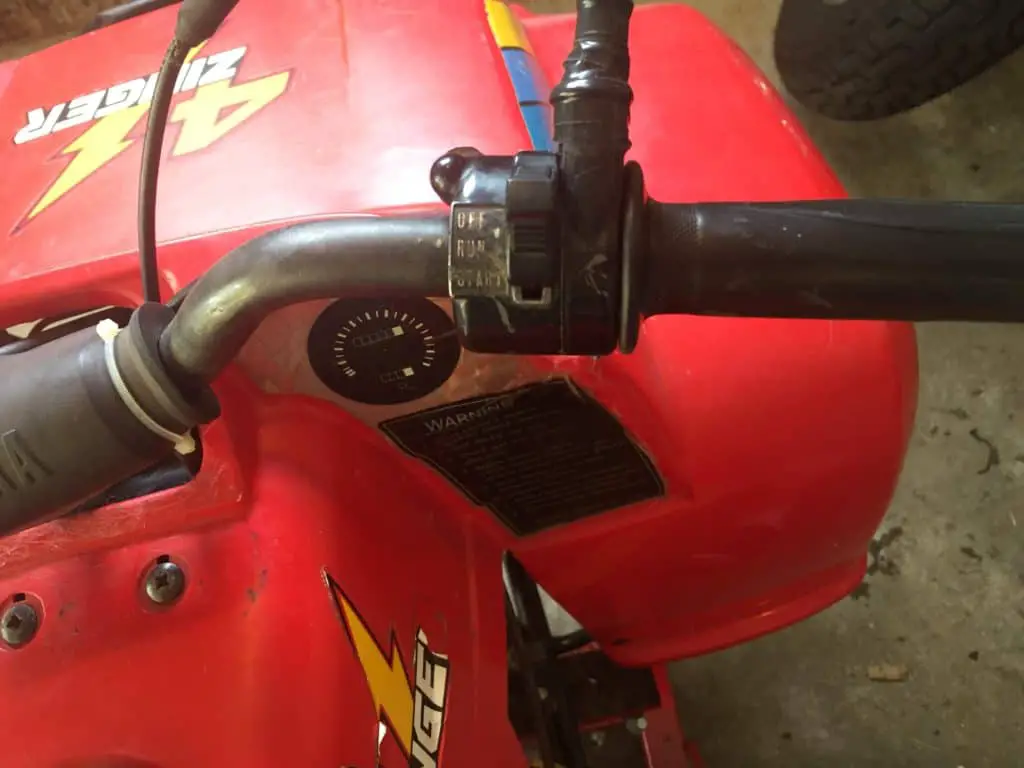
On older ATVs you may have to change or add the kill switch. The ATV my daughter has will be modified. Right now it is up for me to pull activate the kill switch. I pull a rope attached to a key which enables the ATV to run.
I will take the rope off and putting a tether from the key to my daughter. When she falls off the key will get pulled shutting off the motor.
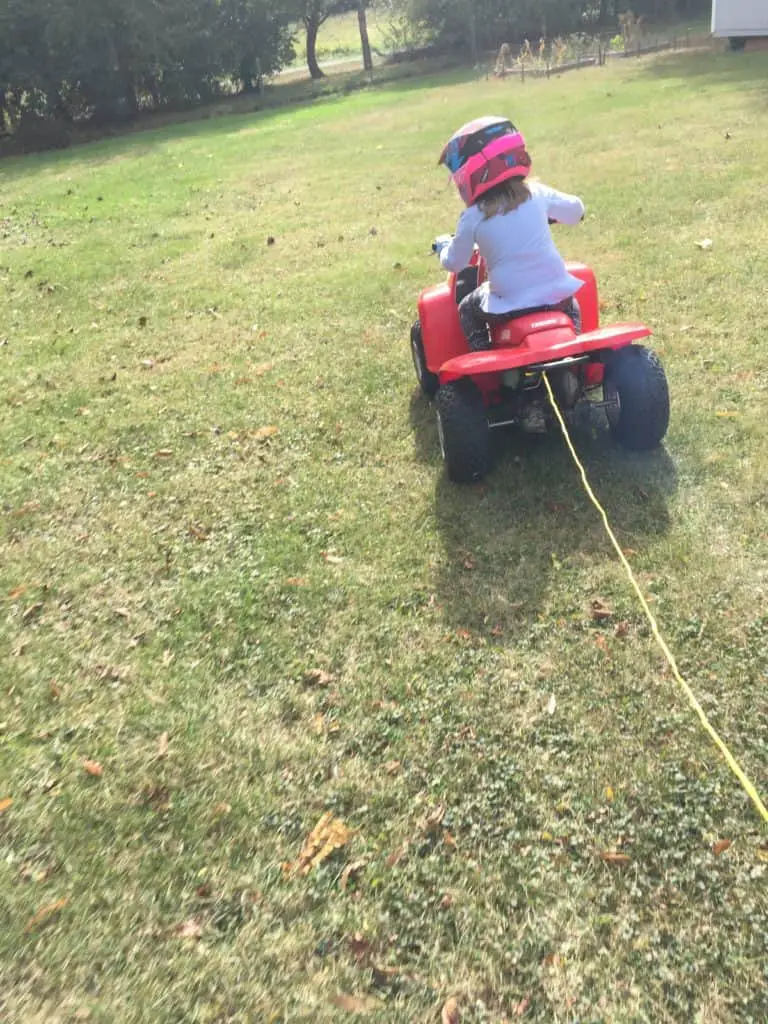
Throttle Stop
I mentioned this a few times already but putting this on your youth ATV is essential for a few reasons.
- If you scare your child by letting the ATV go too fast, they may not want to ride again. The point is to have fun riding.
- It will help them gain confidence and master skills at a slower speed before advancing to a quicker speed.
- Obviously, this will be much safer than letting your new rider go full blast.
- You can easily change the top speed with a small screwdriver and wrench. It does not take a lot of mechanical knowledge to speedup or slow down the motorbike.
Accidents Are Going To Happen
We covered the four steps outlined at the start of the article. Know that even with a safety mindset and all the training and practice, accidents will happen.
You should not freak out and take the ATV away from the child. Know this is just the next step in the child’s progress from learning to ride a bike to driving a car.
When your little one was learning to ride a bike, you knew they would crash. What did you do? You went through the same process we talked about here. You had the child wear a helmet and maybe some elbow or knee pads to keep them from getting skinned up. You had them practice on the sidewalk or drive before riding in the street. I bet you even had them sitting on the bicycle to get comfortable.
I think someone can make a sound argument that having your child learn to ride an ATV or dirt bike will even make them a better driver when they turn 16. Think about the skills they will have which otherwise would not have been learned.
Related Questions:
What is an appropriate age for a child to ride an ATV? This will vary by who you ask and state law. We can clearly see though there are ATVs made for small children. A good age to start is 6 years if the child has already mastered other similar tasks like riding a bicycle and they show good judgement riding.
How do you ride an automatic ATV? Riding an automatic ATV is like driving an automatic car. You put on proper equipment, start the ATV, and put it into gear (some ATVs only have one gear so you will not worry about this step). Lastly, you give the ATV some gas and you move forward.
